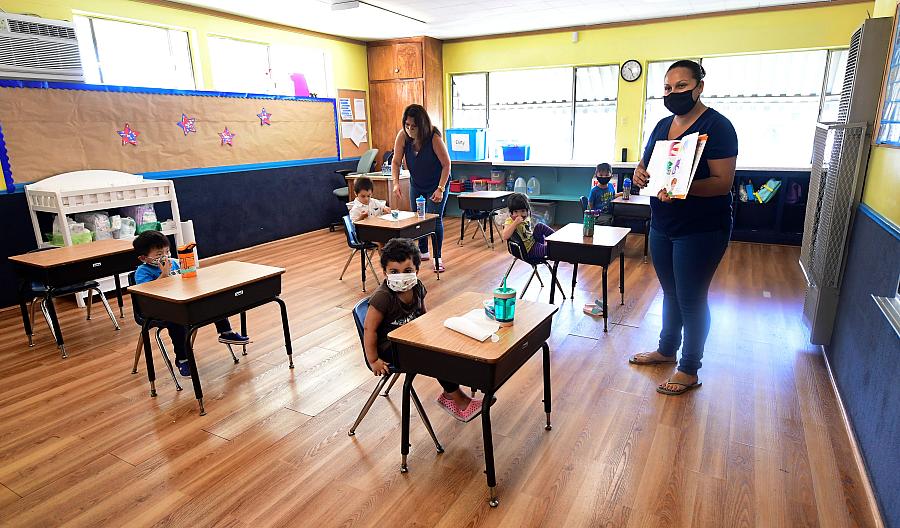Keep these ideas in mind when covering the crisis facing America’s schools

With coronavirus cases soaring, school districts nationwide are reconsidering plans to open, with many now pivoting to full-time remote learning for the coming school year.
Still others are pushing forward with in-person classes, reconfiguring classrooms and researching personal protective equipment even as teachers voice concerns.
“There’s a mad scramble going on right now,” said Tawnell Hobbs, the national K-12 education reporter for The Wall Street Journal, in a Center for Health Journalism Covering Coronavirus webinar this week.
Hobbs joined W. Steven Barnett, senior co-director of the National Institute for Early Education Research (NIEER) and Joel E. Cisneros, director of school mental health at the Los Angeles Unified School District, to discuss the potential impact of these decisions on the country’s most vulnerable populations, innovative approaches to remote learning, and ideas for fresh media coverage on the topic.
Widening the education gap
Public preschool programs have been shown to help address inequalities that start at an early age. When these programs are shut down, the educational gap widens, Barnett said.
“The pandemic has thrown us backward,” he said.
Already, African American, Latino and low-income children lag their white and more affluent peers in math and reading at kindergarten entry, he said. If those gaps aren’t addressed early on, it’s much harder for schools to erase them later in a child’s academic career.
In a new survey of parents with children ages 3 to 5, NIEER asked more about families’ remote experiences, especially the difficulties in meeting young children’s learning needs while facing work and environmental stressors yourself.
“The short story is, it was a disaster,” he said.
In interviews with families, WSJ’s Hobbs also heard about the disproportionate impact of remote learning on minority and poor kids. Some homes don’t have internet and parents with jobs outside the home can’t help their children learn remotely.
Once schools do return to in-person learning, they’ll have to decide whether to plow ahead with the current grade-level materials, even though some kinds may not have competed last year’s curriculum.
“How do you teach algebra when a kid hasn’t learned pre-algebra?” she said.
Finding ways to connect remotely
The best place for children to learn is a school setting where they are not only exposed to academics but also the kind of social and emotional learning that comes from interacting with other people, Cisneros said. But since physical schooling isn’t an option — LAUSD already announced it will start the year remotely — the district is working to connect with the community virtually in an attempt to close the participation gap.
For example, the district launched a mental health hotline that has fielded thousands of calls on everything from the losses students might be facing to health care and financial struggles. The hotline has given staff a window into what families are juggling in order to manage remote schooling — everything from worries about job losses and evictions to struggles to get health care.
“At the core, it’s really people having a hard time managing the stress of this, coupled with kind of the uncertainty of this, too,” he said.
To support parents and caregivers, the district has developed webinars on stress management and emotional regulation. The idea is that better parental coping strategies will help students at home.
Covering the schools dilemma
Hobbs suggested several ideas for journalists interested in covering the dilemmas many districts are now facing.
If schools in your area are opening, ask how much they’re spending on personal protective gear and how they’re purchasing it. What strategies will they implement to keep students distanced? And, how do districts plan to address students’ mental health needs and offer additional academic support?
Reporters should also look into how a district plans to handle COVID-19 positive cases: At what point will they shut down the entire school? What are the protocols for sick children? Could a kid with the sniffles end up in an isolation room with COVID-19 positive kids? Ask your local school officials how they plan to sort through these kinds of planning headaches.
Other ideas to keep on your radar: what kind of budget cuts are districts facing due to the downturn? Are reserves available to help?
Child care issues still haven’t been discussed enough, Hobbs said. What are parents doing if they’re back to work, but schools are turning to a remote or hybrid model? Is your district doing anything to address families’ child care needs? If not, why not?
Also, keep an eye on trends such as remote schooling pods, which can exacerbate inequities and the achievement gap. Are affluent families hiring teachers to run mini private schools? Will some schools prioritize bringing students back who need more hands-on learning or who don’t have technology access at home?
Barnett urged reporters to look at what gets lost when states, local agencies and parents make decisions based on their own costs and benefits, without looking at the bigger picture.
He pointed to the assumption that remote schooling is safer for kids. But, if students are home, are they insulated from exposure? How many people are coming in and out of the home and are they wearing protective gear?
He said he hopes school leaders will think “outside the usual box” when exploring new educational ideas. For example, with so many artists, musicians and theater groups unable to work right now — is there a way to connect these resources to supplement arts education?
“There are these unemployed resources all over,” he said. “The questions is: How do we get someone thinking about putting them all together to meet the needs of children and families?”
**
Watch the full presentation here:

